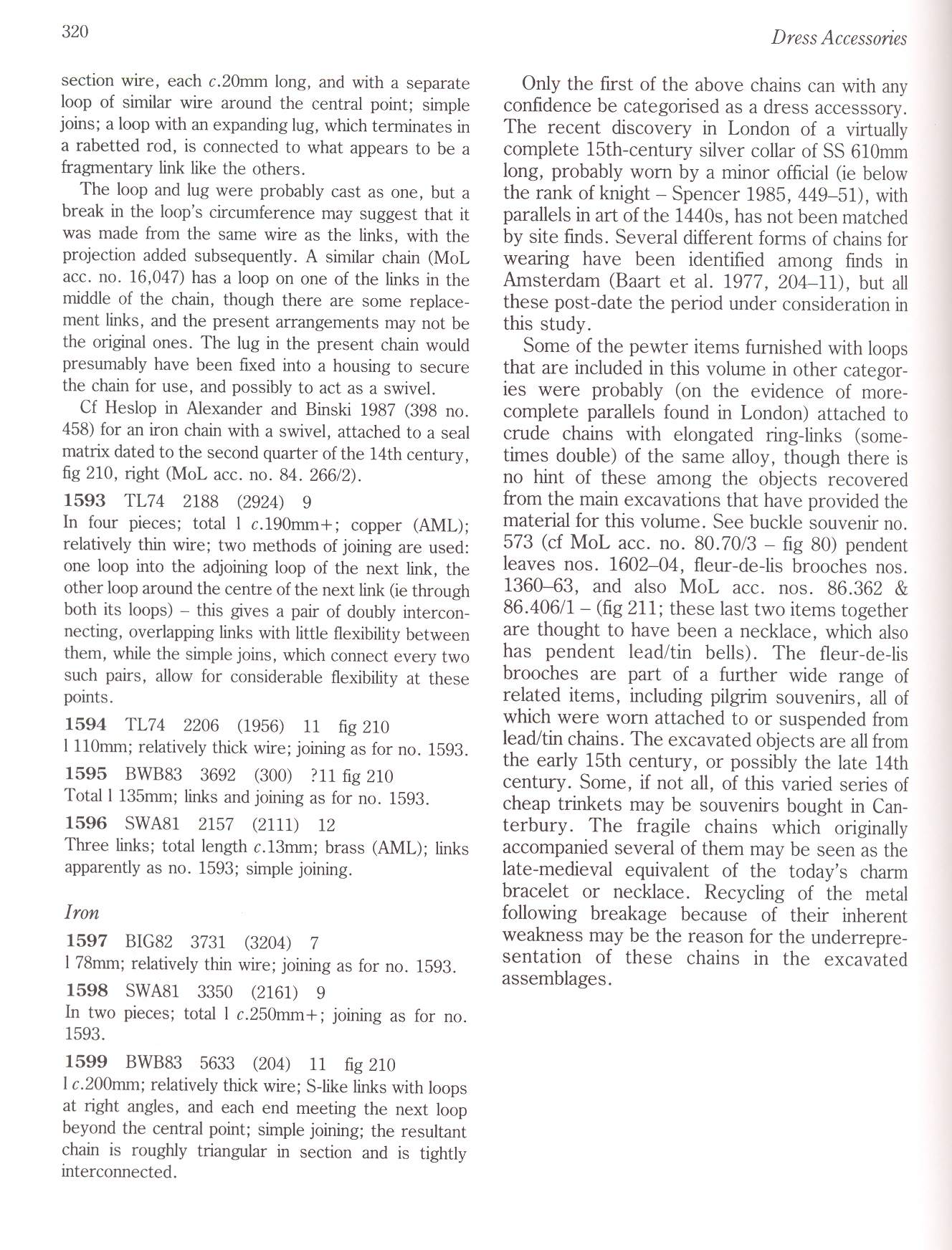347 (22)

320
Dress Accessońes
section wire, each c.20mm long, and with a separate loop of similar wire around the central point; simple joins; a loop with an expanding lug, which terminates in a rabetted rod, is connected to what appears to be a fragmentary link like the others.
The loop and lug were probably cast as one, but a break in the loop’s circumference may suggest that it was madę from the same wire as the links, with the projection added subsequently. A similar chain (MoL acc. no. 16,047) has a loop on one of the links in the middle of the chain, though there are some replace-ment links, and the present arrangements may not be the original ones. The lug in the present chain would presumably have been fixed into a housing to secure the chain for use, and possibly to act as a swivel.
Cf Heslop in Alexander and Binski 1987 (398 no. 458) for an iron chain with a swivel, attached to a seal matrix dated to the second quarter of the 14th century, fig 210, right (MoL acc. no. 84 . 266/2).
1593 TL74 2188 (2924) 9
In four pieces; total 1 c.l90mm+; copper (AML); relatively thin wire; two methods of joining are used: one loop into the adjoining loop of the next link, the other loop around the centre of the next link (ie through both its loops) - this gives a pair of doubly intercon-necting, overlapping links with little flexibility between them, while the simple joins, which connect every two such pairs, allow for considerable flexibility at these points.
1594 TL74 2206 (1956) 11 fig 210
1 llOmm; relatively thick wire; joining as for no. 1593.
1595 BWB83 3692 (300) ?11 fig 210
Total 1135mm; links and joining as for no. 1593.
1596 SWA81 2157 (2111) 12
Three links; total length c.l3mm; brass (AML); links apparently as no. 1593; simple joining.
Iron
1597 BIG82 3731 (3204) 7
1 78mm; relatively thin wire; joining as for no. 1593.
1598 SWA81 3350 (2161) 9
In two pieces; total 1 c.250mm+; joining as for no. 1593.
1599 BWB83 5633 (204) 11 fig 210
1 c.200mm; relatively thick wire; S-like links with loops at right angles, and each end meeting the next loop beyond the central point; simple joining; the resultant chain is roughly triangular in section and is tightly interconnected.
Only the first of the above chains can with any confidence be categorised as a dress accesssory. The recent discovery in London of a virtually complete 15th-century silver collar of SS 610mm long, probably wom by a minor official (ie below the rank of knight - Spencer 1985, 449-51), with parallels in art of the 1440s, has not been matched by site finds. Several different forms of chains for wearing have been identified among finds in Amsterdam (Baart et al. 1977, 204-11), but all these post-date the period under consideration in this study.
Some of the pewter items fumished with loops that are included in this volume in other categor-ies were probably (on the evidence of more-complete parallels found in London) attached to crude chains with elongated ring-links (some-times double) of the same alloy, though there is no hint of these among the objects recovered from the main excavations that have provided the materiał for this volume. See buckie souvenir no. 573 (cf MoL acc. no. 80.70/3 - fig 80) pendent leaves nos. 1602-04, fleur-de-lis brooches nos. 1360-63, and also MoL acc. nos. 86.362 & 86.406/1 - (fig 211; these last two items together are thought to have been a necklace, which also has pendent lead/tin bells). The fleur-de-lis brooches are part of a further wide rangę of related items, including pilgrim souvenirs, all of which were wom attached to or suspended from lead/tin chains. The excavated objects are all from the early 15th century, or possibly the late 14th century. Some, if not all, of this varied series of cheap trinkets may be souvenirs bought in Can-terbury. The fragile chains which originally accompanied several of them may be seen as the late-medieval equivalent of the today’s charm bracelet or necklace. Recycling of the metal following breakage because of their inherent weakness may be the reason for the underrepre-sentation of these chains in the excavated assemblages.
Wyszukiwarka
Podobne podstrony:
sql2 2302 Oirecl access lo tables: Each program is responsiOle for maintaining transaction integrity
sql2 2302 Direcl access lo lables: Each program is responsible for maintaining transaction integrity
361 (22) 334Dress Accessories seam on lower part of hoop opposite bezel. Extemal d 25mm; internal d
365 (22) 338Dress Accessońes 1644 BWB83 acc. no. 3508 (context 175) ceramic phases 6-9 fig 221 Top h
image001 A section of the wali rippcd boso and a solid, glassy column of wałor tmashed Haywood whera
img166 (3) 22 22 CN: Use a light blue for D, black for F, and gray for H. (1) Do n
Table of Contents Topie 1, DESCRIBE THE OPERATION OF DATA NETWORKS (75 ąuestions) 5 Section 1: Descr
slowenia auto mapa winiety Avtocestni odseki z obvezno uporabo vinjetMotorway sections with compulso
exe01 4 Correct the mistake in each of these sentences. Ignore the italłcs. u/as a) &nbs
156 V.P. Yuryev, N.K. Genkina, L.A. Wasserman from each other. It implies that melting temperatures
.6 surface to the resistance of the water while, on the forward stroke, each moves freely and, shar
Locałion area Each MSC/VLR Service Area is subdivided into a number of location areas (LA). The subd
więcej podobnych podstron